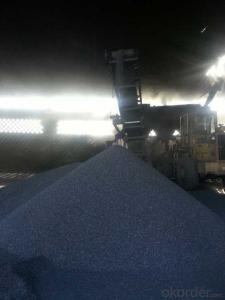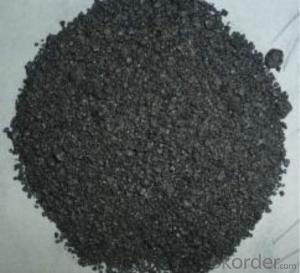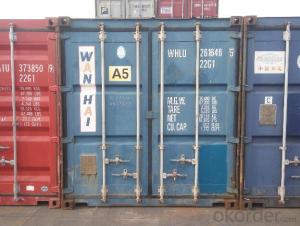FC 99% Calciend Petroleum Coke as Injection Carbon
- Loading Port:
- Tianjin
- Payment Terms:
- TT OR LC
- Min Order Qty:
- 20.1
- Supply Capability:
- 2010 m.t./month
OKorder Service Pledge
OKorder Financial Service
You Might Also Like
Brief introduction
Calcined Petroleum Coke comes from delayed coke which extracted from oil refinery. Although Calcined Petroleum Coke contains a little bit higher level of sulfur and nitrogen than pitch coke, the price advantage still makes it widely used during steel-making and founding as a kind of carbon additive/carburant. It is playing more and more important role in the industry.
BaoSteel is world famous organization. This calcined petroleum coke's raw material is from Bao Steel, which has great quality guarantee. Bao Steel also named this coke as Pitch Coke.
Features
Our product has follwing advantages:
The morphology, chemistry and crystallinity of recarburisers
have a major impact on the overall casting cost. The combined
application and cost benefits, which are derived through the
use of Desulco, enable foundries to manufacture castings in a
highly cost effective manner.
reduces
Recarburiser consumption
Power consumption
Inoculant consumption
MgFeSi consumption
Furnace refractory wear
Scrap rate
Tap to tap time
Slag inclusions risk
Chill
increases
Casting microstructure
Productivity
Process consistency
Specifications
Products | CPC | ||
F.C.% | 98.5MIN | 98.5MIN | 98MIN |
ASH % | 0.8MAX | 0.8MAX | 1MAX |
V.M.% | 0.7 MAX | 0.7 MAX | 1 MAX |
SULFUR % | 0. 5MAX | 0. 7MAX | 1MAX |
MOISTURE % | 0.5MAX | 0.5MAX | 1MAX |
Pictures




FAQ
1 What is the package?
In jumbo bag with/without pallet
2 What is the delivery time?
25 days after receiving the workable LC or down payment
3 What is the payment term?
T/T, L/C,D/P,D/A
- Q: What is carbon offsetting in aviation?
- The aviation industry utilizes carbon offsetting as a mechanism to counterbalance the carbon emissions it generates. Since airplanes contribute significantly to greenhouse gas emissions, carbon offsetting offers a means for airlines and passengers to acknowledge their carbon footprint and contribute to the battle against climate change. The carbon offsetting process involves calculating the quantity of carbon dioxide and other greenhouse gases released during a flight, and subsequently investing in projects that decrease an equal amount of emissions elsewhere. These projects may encompass initiatives involving renewable energy, forest preservation, or methane capture. The objective is for the emissions reduced or eliminated by these projects to compensate for the emissions produced by the aviation industry. To partake in carbon offsetting, airlines or passengers can acquire carbon offsets, which essentially represent credits equivalent to the reduction or elimination of one metric ton of carbon dioxide or its equivalent. These offsets are generated by certified projects that adhere to stringent standards and undergo independent verification. By investing in carbon offsets, the aviation industry can contribute to global endeavors aimed at reducing greenhouse gas emissions and mitigating the impact of air travel on climate change. It enables airlines and passengers to promptly take action to counteract the environmental repercussions of flying, as the reduction or elimination of emissions from offset projects helps to balance out the emissions generated by air travel. It is crucial to note that carbon offsetting in aviation should not serve as a means to justify or neglect the necessity of long-term solutions to reduce emissions from aircraft. Instead, it should be regarded as a supplementary measure to other strategies, such as investing in more fuel-efficient aircraft, utilizing sustainable aviation fuels, and implementing operational improvements. Nonetheless, carbon offsetting does provide a valuable tool to mitigate emissions in the short term, while the aviation industry endeavors to adopt more sustainable practices.
- Q: Which is better, 13 and 14 carbon breath tests?
- Two kinds of carbon synthesis conditions are different, the instruments are not the same, so lead to price differences
- Q: What is carbon fixation in biology?
- Carbon fixation in biology refers to the process by which carbon dioxide (CO2) from the atmosphere is converted into organic compounds by living organisms. It is a crucial step in the global carbon cycle and is primarily carried out by autotrophic organisms, such as plants, algae, and certain bacteria. During carbon fixation, the enzyme RuBisCO (ribulose-1,5-bisphosphate carboxylase/oxygenase) catalyzes the reaction between CO2 and a five-carbon sugar molecule called ribulose bisphosphate (RuBP). This reaction produces two molecules of a three-carbon compound called 3-phosphoglycerate (3-PGA). This initial step is known as the Calvin cycle or C3 photosynthesis. In plants, the 3-PGA molecules are then converted into other organic compounds, such as sugars, starches, and cellulose, through a series of enzymatic reactions. These organic compounds serve as building blocks for the plant's growth and development. Carbon fixation plays a critical role in maintaining a balance of atmospheric CO2 levels and is a key process in regulating climate change. It allows for the transfer of carbon from the atmosphere into the biosphere, ultimately reducing the concentration of greenhouse gases and mitigating the effects of global warming. Moreover, carbon fixation is essential for sustaining life on Earth as it provides the basis for food chains and supports the growth of other organisms. Heterotrophs, including animals and humans, depend on the organic compounds produced by autotrophs through carbon fixation for their energy and nutritional needs. Overall, carbon fixation is a fundamental process in biology that enables the conversion of atmospheric carbon dioxide into organic compounds, sustaining life and helping to regulate the Earth's climate.
- Q: What is diamond?
- Diamond is a precious gemstone that is highly valued for its exceptional hardness, brilliance, and rarity. It is a form of carbon that has undergone intense heat and pressure deep within the Earth's mantle, resulting in its unique crystal structure. Known for its dazzling sparkle, diamond is transparent and colorless, although it can also occur in various colors such as yellow, blue, pink, and green due to impurities present during its formation. Diamonds are renowned for their use in jewelry, as they are cut and polished into various shapes to maximize their brilliance. Additionally, diamonds possess remarkable durability and are commonly used in industrial applications such as cutting, grinding, and drilling due to their strength. Overall, diamond's extraordinary beauty, durability, and scarcity have made it one of the most sought-after gemstones in the world.
- Q: What are the consequences of increased carbon emissions on urban areas?
- Urban areas are significantly affected by the increase in carbon emissions, which have notable impacts on various aspects. One of the most significant consequences is the worsening of air pollution. The release of harmful pollutants like nitrogen oxides and particulate matter is contributed by carbon emissions, especially from vehicles and industrial activities. These pollutants can cause respiratory problems, worsen existing health conditions, and increase the risk of lung cancer and cardiovascular diseases among urban residents. Moreover, the increase in carbon emissions leads to the occurrence of urban heat islands. This happens because carbon dioxide and other greenhouse gases trap heat in the atmosphere, resulting in higher temperatures in urban areas. This effect is particularly pronounced due to the abundance of concrete and asphalt surfaces that absorb and radiate heat. Consequently, urban areas experience higher temperatures compared to nearby rural areas, further intensifying the discomfort and health risks associated with heat stress, particularly for vulnerable populations like the elderly and those with limited access to cooling resources. The consequences of increased carbon emissions also extend to the natural environment. Urban green spaces and ecosystems are negatively affected as higher levels of carbon dioxide disrupt plant growth and reduce biodiversity. This exacerbates the loss of natural habitats and the degradation of urban ecosystems, leading to a decline in the provision of ecosystem services such as air purification, temperature regulation, and stormwater management. Additionally, increased carbon emissions have economic implications for urban areas. As carbon emissions rise, the cost of addressing climate change-related challenges like flooding and extreme weather events increases. This puts a strain on the budgets of local governments and may result in higher taxes or reduced funding for other essential services. To tackle these consequences, it is crucial for urban areas to implement strategies that reduce carbon emissions and promote sustainability. This includes investing in public transportation, encouraging the use of renewable energy sources, promoting energy-efficient buildings, and implementing policies to reduce vehicle emissions. By adopting these measures, urban areas can mitigate the negative effects of increased carbon emissions and create healthier, more sustainable environments for their residents.
- Q: Stability, primary carbon, two carbon, three carbon, four carbon
- (2) due to free radicals generated in the outer layer of only 7 electrons, eight corner structure did not reach saturation, so it is an electron deficient species, while methyl (or alkyl) is an electron donor groups can alleviate the lack of this kind of electron, so that the stable free radicals, free radicals and carbon alkyl substituents on the more, the more stable free radical. And more stable, more easy to generate.
- Q: What is carbon nanocomposite coating?
- Carbon nanocomposite coating is a thin layer of material that contains carbon nanoparticles, which are dispersed within a polymer matrix. This coating is known for its exceptional strength, durability, and electrical conductivity, making it useful in various industries such as aerospace, automotive, and electronics.
- Q: What role does carbon play in photosynthesis?
- Carbon plays a crucial role in photosynthesis as it is the primary element used by plants to produce organic compounds. During photosynthesis, plants absorb carbon dioxide from the atmosphere and use it to synthesize glucose, a simple sugar that serves as a building block for more complex carbohydrates, such as starch and cellulose. This process occurs in the chloroplasts of plant cells, specifically in the stroma of the chloroplast, where the enzyme RuBisCO catalyzes the fixation of carbon dioxide into an organic molecule called PGA (phosphoglycerate). Through a series of reactions known as the Calvin cycle, PGA is converted into glucose, which can be stored for energy or used for growth and reproduction. In summary, carbon is essential for photosynthesis as it provides the raw material necessary for plants to produce their own food and sustain life.
- Q: What is carbon nanotube?
- Carbon nanotubes are cylindrical structures made up of carbon atoms arranged in a unique hexagonal lattice pattern. They are incredibly small, with diameters on the nanometer scale (about 1 billionth of a meter) and lengths that can range from a few nanometers to several centimeters. Carbon nanotubes possess remarkable properties that make them highly attractive for a wide range of applications. They are incredibly strong, with tensile strength that exceeds that of any other known material, making them ideal for use in structural composites. They also have excellent electrical conductivity, thermal conductivity, and are chemically stable, which makes them useful in fields such as electronics, energy storage, and catalysis. There are two main types of carbon nanotubes: single-walled nanotubes (SWNTs) and multi-walled nanotubes (MWNTs). Single-walled nanotubes consist of a single layer of carbon atoms rolled into a tube, while multi-walled nanotubes consist of multiple concentric layers of carbon atoms. The arrangement of carbon atoms and the diameter of the tube determine the properties of the nanotube. Carbon nanotubes have the potential to revolutionize various industries due to their unique properties. They are being explored for applications in electronics, where they can be used as high-performance transistors, interconnects, and sensors. They also hold promise in the field of energy storage, as they can be used in batteries and supercapacitors that have higher energy densities and faster charging rates. Additionally, their high surface area and unique chemical properties make them suitable for catalytic applications, such as water purification and chemical synthesis. Despite their immense potential, there are still challenges to overcome in the large-scale production and commercialization of carbon nanotubes. However, ongoing research and development efforts continue to push the boundaries of their applications, making carbon nanotubes an exciting field of study with significant future possibilities.
- Q: How does carbon impact the availability of sustainable development policies?
- Carbon impacts the availability of sustainable development policies by directly contributing to climate change. The excessive emission of carbon dioxide and other greenhouse gases from human activities leads to global warming, which in turn affects natural resources, ecosystems, and communities. To mitigate the negative impacts of carbon, sustainable development policies aim to reduce carbon emissions, promote renewable energy sources, and encourage sustainable practices. By addressing carbon emissions, these policies help create a more sustainable future by preserving resources, minimizing environmental degradation, and fostering social and economic well-being.
Send your message to us
FC 99% Calciend Petroleum Coke as Injection Carbon
- Loading Port:
- Tianjin
- Payment Terms:
- TT OR LC
- Min Order Qty:
- 20.1
- Supply Capability:
- 2010 m.t./month
OKorder Service Pledge
OKorder Financial Service
Similar products
Hot products
Hot Searches

























